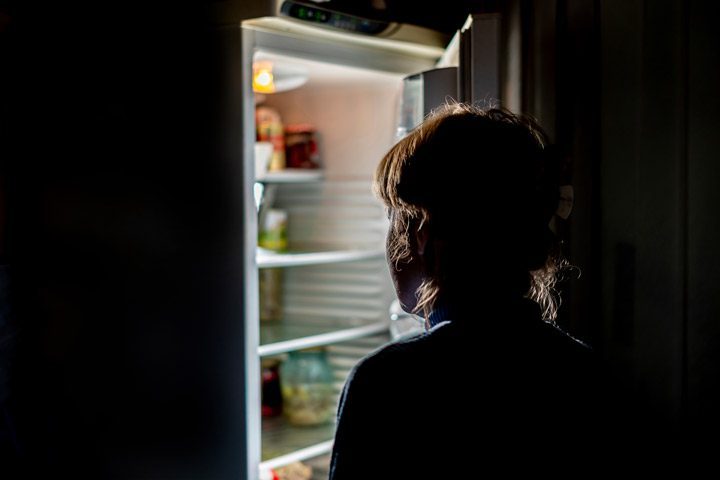
Although you might be familiar with eating disorders such as anorexia nervosa or bulimia, night-eating syndrome, or NES, is more along the lines of binge eating. However, it’s still a different disorder altogether, and anyone who suffers from it requires comprehensive individualized treatment.
Understanding Night-Eating Syndrome
People are often surprised to learn that NES was first recognized in 1955—and then largely ignored for another 40 years. As of 2015, the American Psychiatric Association (APA) Diagnostic Statistical Manual−5 (DSM-5) classifies NES as an Other Specified Feeding or Eating Disorder (OSFED).
Frontiers in Psychology (FIP) details more signs and symptoms of NES, which we provide verbatim. Individuals often experience:
- Evening hyperphagia, defined as the consumption of 25 percent or more of total daily caloric intake after the evening meal, and/or two nocturnal ingestions on average per week.
- Awareness of one’s eating behaviors and ingestions.
- Three of the following: (i) morning anorexia, (ii) the desire to eat between dinner and sleep, (iii) sleep onset insomnia, (iv) the belief that one needs to eat in order to fall asleep, (v) depressed or lowering of mood in the evening and night time.
- Distress or impaired functioning.
- A period of three months or more under these conditions.
- These conditions are not secondary to any medical condition.
Hormonal issues, high stressors, and difficulty calibrating the sleep-wake cycle might also contribute to the NES development. The National Eating Disorder Association provides an extensive list of possible behaviors associated with this syndrome.
According to WebMD, “NES affects a little more than 1 in 100 people. If you’re obese, there’s about a 1 in 10 chance you have it.” Although the full reasons for developing the syndrome aren’t clear, WebMD notes that “you’re more likely to have night eating syndrome if you’re obese or have another eating disorder. A history of depression, anxiety, and substance abuse are more common in people with NES.” There’s also speculation that a defect in PER1, a gene that helps regulate your body clock, might also be a risk factor for NES.
Currently, there isn’t any qualitative data as to whether the condition is more prevalent in women, men, or non-binary individuals.
While depression and obesity might be common symptoms NES and binge-eating disorder (BED) share, FIP states the difference between the two disorders is time and intake. “While BED patients experience “Loss of Control” (LoC) overeating and consume uncharacteristically large meals, NES patients tend to retain their control and “snack” at atypical times, i.e., at night or after the evening meal.” However, FIP also points out that more research is necessary to truly distinguish characteristics of each disorder.
Treating Night-Eating Syndrome
A clinical overview of the condition published in 2012 indicates that “the host of symptoms associated with NES makes the syndrome best conceptualized as a combination of eating, sleeping, mood, and stress disorder features. Using the proposed criteria can help standardize NES assessment and diagnosis, and can create a framework for future research of NES characteristics and treatments.”
Since less is known about NES than other clearly classified eating disorders, each case presents a new treatment challenge. To determine NES, healthcare professionals start by evaluating a person’s eating and sleep habits, and perhaps asking them to undergo a sleep test. WebMD says “to be diagnosed with NES, you need to overeat at night for at least three months. The eating and sleeping patterns also can’t be due to substance abuse, a medical disorder, medication, or another psychiatric issue.”
Currently, the most common NES treatment includes a combination of:
- Cognitive behavioral therapy and/or dialectical therapy
- Alternative and holistic therapies, such as progressive muscle relaxation and phototherapy (light therapy similar to what’s used for seasonal affective disorder or SAD)
- Medication, especially if sleep aids are recommended to reset a person’s circadian rhythm or an evaluation also discovers anxiety and depression
- Supplements, such as melatonin, to help recalibrate sleep patterns
The best way to get effective treatment for NES is to be open and honest about eating behaviors, especially if you’re concerned you might have a health issue.
Find Comprehensive Care at Cottonwood Tucson
Eating disorders should always be taken seriously, as they’re often an outward sign of internal pain, and have a severe impact on health in the long run. The board-certified staff at Cottonwood Tucson combines quality physical and psychological care with compassion and education to help each person redefine wellness and live a better life. Ask how we can help you or a loved one find clarity and renewed joy.






